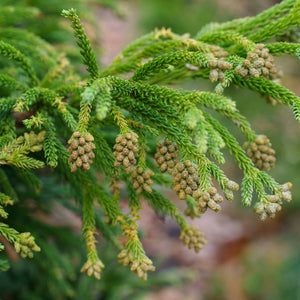The Cryptomeria Guide
Cryptomeria japonica, commonly known as Japanese Cedar, is a striking evergreen conifer prized for its soft, dense foliage and elegant form. Native to Japan and China, this graceful tree offers year-round beauty and exceptional versatility in the landscape. With a range of cultivars suited to both large and small spaces, Cryptomeria can function as a bold specimen, a privacy screen, or even a sculptural focal point in gardens with limited space.
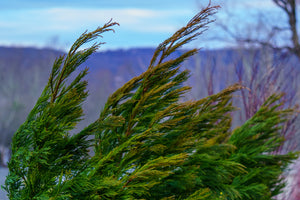
About
Cryptomeria belongs to the cypress family (Cupressaceae) and is the national tree of Japan. While the species can grow to over 60 feet tall in optimal conditions, a wide variety of cultivated forms—such as Cryptomeria japonica 'Black Dragon', Cryptomeria japonica 'Globosa Nana', and Cryptomeria japonica 'Yoshino'—offer more manageable sizes and shapes for residential landscapes. Some, like Cryptomeria japonica 'Twinkle Toes' or Cryptomeria japonica 'Little Champion', are compact enough for small gardens and container use.
The tree is known for its bright green, needle-like foliage that turns bronze or coppery in colder weather, a seasonal change that adds winter interest. Bark peels in long strips, revealing reddish-brown tones that lend character to mature specimens.
Cryptomeria is generally deer-resistant, non-toxic to pets, and relatively easy to care for, making it a low-maintenance choice for many settings. With their tidy growth habit and tolerance for pruning, many cultivars can also be shaped to fit formal designs or soften hardscapes.
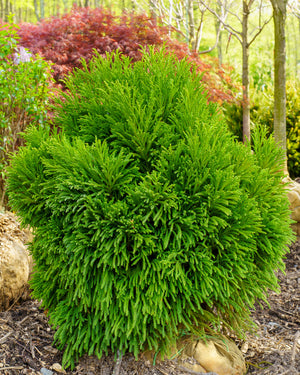
PLANTING
Cryptomeria is adaptable, but planting it in the right spot ensures long-term success and a strong, healthy structure.
USDA Hardiness Zones: Most cultivars thrive in Zones 5–9, though protection from winter winds is recommended in colder regions.
Soil: Prefers moist, well-draining, acidic to neutral soil. Avoid heavy clay or overly dry conditions.
Sunlight: Grows best in full sun to part shade. Some varieties can tolerate light shade, though dense shade can lead to sparse growth.
Watering: Water regularly during establishment. Once mature, Cryptomeria is moderately drought-tolerant but prefers consistent moisture.
Spacing: Large varieties like Cryptomeria japonica 'Yoshino' should be spaced 10–15 feet apart for hedging or privacy screens. Smaller types like 'Globosa Nana' can be spaced 3–5 feet apart.
Planting Time: Early spring or fall is ideal to avoid heat stress and allow roots to establish before temperature extremes.

CARE
Cryptomeria requires minimal maintenance, but a few seasonal practices will help keep it looking its best.
- Watering: Keep the soil evenly moist, especially during dry spells. Mature trees can tolerate short periods of drought but prefer steady hydration.
- Fertilizing: Feed in early spring with a balanced, slow-release fertilizer formulated for evergreens.
- Pruning: Light pruning can shape the tree or remove winter damage. Best done in late winter or early spring before new growth appears. Cryptomeria responds well to trimming and can be sheared if used as a hedge.
- Mulching: Apply 2-3 inches of mulch around the base to retain moisture and suppress weeds, keeping it away from the trunk.
- Winter Color Change: Foliage may bronze or take on a purplish hue in winter. This is a natural response to cold and not a sign of stress.
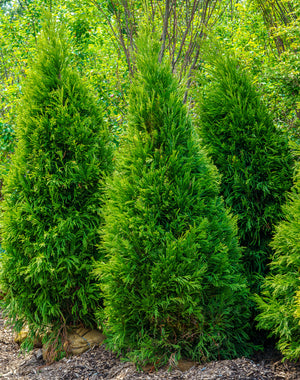
HOW TO USE
Cryptomeria adds year-round texture, color, and form to the landscape. Whether you're designing a traditional Japanese garden or a modern suburban yard, there is likely a variety to suit your space.
- Privacy Screens: Tall cultivars like Cryptomeria japonica 'Yoshino' and 'Radicans' make excellent fast-growing evergreen screens for year-round privacy.
- Specimen Trees: Use striking varieties like 'Black Dragon' or 'Sapphire Nymph' as focal points in garden beds, especially where their color or form can be appreciated.
- Foundation Plantings: Compact cultivars like 'Globosa Nana' and 'Little Champion' are well-suited for softening corners or flanking entryways.
- Mixed Borders: Pair Cryptomeria with companion plants such as Camellia, Rhododendron, or Hydrangea for layered interest and year-round structure.
- Rock Gardens & Containers: Dwarf types like 'Mushroom' and 'Twinkle Toes' add texture to container gardens or small-scale rockeries.
With the right placement, Cryptomeria can easily become the focal point of your landscape while providing screening, seasonal color, and structure.
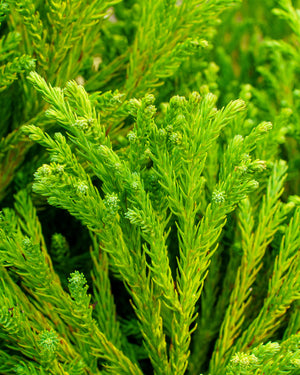
Common Questions
Are Cryptomeria deer resistant? Yes, Cryptomeria is generally not preferred by deer and is considered deer-resistant.
Can Cryptomeria grow in shade? It tolerates part shade but performs best in full sun for dense, healthy growth.
Can you prune Cryptomeria? Yes, light pruning is well tolerated and can help maintain shape or encourage bushiness.
Do Cryptomeria turn brown in winter? Some cultivars develop bronze or copper tones in winter, which is a natural response to cold and not a health issue.
How fast do Cryptomeria grow? Growth rates vary by cultivar. Larger varieties can grow 1–2 feet per year under ideal conditions.
How tall do Cryptomeria grow? Full-size trees can reach 40–60 feet tall, while dwarf forms may only reach 2–6 feet at maturity.
How to prune Cryptomeria? Prune in late winter or early spring to remove damaged or crossing branches. Avoid cutting into old wood, as regrowth may be slow.
Conclusion
Cryptomeria offers a range of shapes, sizes, and textures, making it a highly adaptable evergreen for diverse garden settings. Whether you're looking to create privacy, highlight a focal point, or add structure to a mixed border, this deer-resistant and relatively low-maintenance tree deserves a place in your design. From the graceful arcs of 'Radicans' to the tidy form of 'Globosa Nana', there's a Cryptomeria for every garden.
The Cryptomeria Collection
Sold Out
Sold Out
Sold Out
Sold Out


